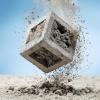
Breaking News
 Japan just injected artificial blood into a human. No blood type needed. No refrigeration.
Japan just injected artificial blood into a human. No blood type needed. No refrigeration.
 China Just Dropped a 6% TAX on Gold - The Market Wasn't Ready for This
China Just Dropped a 6% TAX on Gold - The Market Wasn't Ready for This
 Banks' Strategic Silver Market Manipulation During Off-Hours Trading
Banks' Strategic Silver Market Manipulation During Off-Hours Trading
 No new North Sea oil wells for first time since 1960
No new North Sea oil wells for first time since 1960
Top Tech News
 The 6 Best LLM Tools To Run Models Locally
The 6 Best LLM Tools To Run Models Locally
 Testing My First Sodium-Ion Solar Battery
Testing My First Sodium-Ion Solar Battery
 A man once paralyzed from the waist down now stands on his own, not with machines or wires,...
A man once paralyzed from the waist down now stands on his own, not with machines or wires,...
 Review: Thumb-sized thermal camera turns your phone into a smart tool
Review: Thumb-sized thermal camera turns your phone into a smart tool
 Army To Bring Nuclear Microreactors To Its Bases By 2028
Army To Bring Nuclear Microreactors To Its Bases By 2028
 Nissan Says It's On Track For Solid-State Batteries That Double EV Range By 2028
Nissan Says It's On Track For Solid-State Batteries That Double EV Range By 2028
 Carbon based computers that run on iron
Carbon based computers that run on iron
 Russia flies strategic cruise missile propelled by a nuclear engine
Russia flies strategic cruise missile propelled by a nuclear engine
 100% Free AC & Heat from SOLAR! Airspool Mini Split AC from Santan Solar | Unboxing & Install
100% Free AC & Heat from SOLAR! Airspool Mini Split AC from Santan Solar | Unboxing & Install
 Engineers Discovered the Spectacular Secret to Making 17x Stronger Cement
Engineers Discovered the Spectacular Secret to Making 17x Stronger Cement
Broad-spectrum solar breakthrough could efficiently produce hydrogen

Hydrogen is viewed by many folks, particularly in Japan and Korea, as the clean-burning fuel that might power our vehicles in a low-emissions future. One way to produce hydrogen is to split it out of water. This is typically done by splitting water molecules into hydrogen and oxygen using electricity, but a potentially simpler and more efficient way to do it may be through photocatalytic water splitting, which uses light itself as the energy source instead of electricity, removing electricity production from the process altogether.
Nobody has yet managed to commercialize photocatalytic hydrogen production, but it's a hot area of research, and this OSU team claims it's discovered one of the most efficient photocatalytic molecules to date.
The molecule has shown a unique ability to use light from right across the visible spectrum. Where most previous photocatalysts have focused on high-energy ultraviolet wavelengths, this one can capture energy from ultraviolet, all the way through the visible spectrum and well into the near infrared range, meaning it can absorb up to 50 percent more solar energy than current solar cells.



